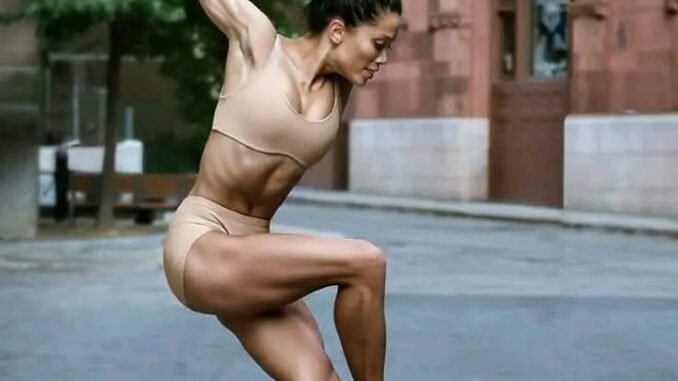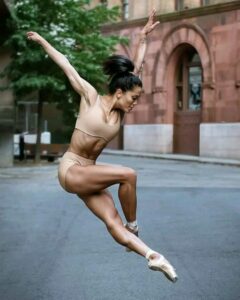
Breaking News: Elon Musk Signs $850 Million Deal with Ballet Star Lia Cirio to Merge Art and Robotics in Tesla’s Boldest Move Yet
In a stunning twist that has sent shockwaves across both the technology and arts industries, Tesla CEO Elon Musk has signed an eye-watering $850 million endorsement deal with world-renowned ballet dancer, Lia Cirio. This three-year collaboration promises to marry the precision, grace, and fluidity of ballet with the cutting-edge robotics and AI technology Tesla is rapidly advancing. The partnership aims to create a new chapter in human-robot interaction—one that could forever reshape how we view and engage with artificial intelligence.

Unlikely Partners: The Tech Titan and the Prima Ballerina
For many, the combination of a technology mogul and a ballet dancer may seem like an unusual pairing. But for those who know Musk, a man who thrives on the unconventional, this alliance makes perfect sense. Cirio, who has long captivated audiences with her breathtaking performances as a principal dancer at the Boston Ballet, is lauded for her ability to effortlessly embody the most challenging aspects of classical and contemporary choreography. Her performances are marked by their precision, an ideal match for Tesla’s vision of creating robots that move and act with a high degree of finesse.
Tesla’s Optimus robot, designed as a general-purpose humanoid, has shown great promise in industries like manufacturing and caregiving, but its movements have been characterized as rigid and lacking in natural fluidity. Musk’s team believes that Cirio’s expertise in movement could help push Tesla’s AI and robotics division to new heights, allowing their robots to learn from the unparalleled elegance and coordination seen in human dancers.
“We’ve mastered speed and intelligence with our AI,” Musk said in a press briefing. “But there’s still so much to learn from the human body. Lia’s artistry will allow us to teach our robots how to move with grace and efficiency, helping them not just to operate faster but to interact with the world in more meaningful ways.”
This innovative partnership is not without precedent. Musk has long been fascinated by the intersection of technology and the arts. From his ambitions with Neuralink, where he hopes to bridge the human brain with AI, to his involvement in space exploration with SpaceX, Musk has always pushed for the merger of two seemingly disparate fields. However, the deal with Cirio marks his most direct foray into the world of fine arts, making it Tesla’s most creative endorsement yet.
Cirio’s Role: Elevating Robotics Through Dance
Under this three-year partnership, Cirio will not only represent Tesla in public appearances but also work directly with the company’s AI and robotics teams. Her task is to help engineers develop movement algorithms that will enable robots like Optimus to master fluid, human-like motions. It’s an idea that seems straight out of a science fiction novel, yet Musk is no stranger to turning the impossible into reality.
Cirio’s background makes her uniquely suited for this role. As a dancer, her entire career has been about discipline, training her body to be an instrument of perfection. She has mastered techniques that require control over the finest of muscle movements, something that Tesla’s AI lacks at the moment. For example, a ballet dancer can alter the placement of a single finger or adjust the height of a leg mid-pirouette with incredible precision, something that current AI and robotic systems struggle to replicate.
“I’ve always believed that movement is a form of art, and through this partnership, I’m excited to explore how art can influence science and technology,” Cirio remarked in a statement. “Dance is about connecting with your audience through every fiber of your being. I think there’s a way we can bring that level of connection and fluidity to robotics, which could change the way people relate to these machines.”
The Vision: A New Era for AI and Robotics
Musk’s broader vision for this collaboration is to make Tesla’s robots more adept at human-like interactions. Today’s robots are great at repetitive tasks, but they often struggle in environments that require delicate maneuvers or adaptability. With Cirio’s influence, Tesla’s robots could be poised to operate in environments like hospitals, elderly care centers, or even in homes, where precision and care are vital.
Incorporating dance into AI design may sound avant-garde, but it taps into a fundamental truth about the human body: movement is a sophisticated form of intelligence. Humans possess an intrinsic understanding of how to distribute their weight, adjust their posture, and anticipate obstacles in their environment. Translating this into code is the challenge Tesla’s engineers are taking on. Musk has even suggested that this collaboration could lead to the creation of a new type of AI—one that combines cognitive intelligence with the emotional intelligence expressed through movement.

Tesla’s Expanding Horizon: Beyond Self-Driving Cars
This partnership is a statement to the world that Tesla’s ambitions extend well beyond electric vehicles and autonomous driving. In fact, the company’s involvement in AI has been growing steadily over the past few years, with their AI Day events showcasing advancements in deep learning and neural networks. But this new chapter signals a pivot towards more advanced forms of AI—those that don’t just think like humans, but move like them too.
Imagine robots with the agility to perform delicate surgeries, assist in rehabilitation therapies, or help in disaster recovery efforts. These are the future scenarios Musk envisions, and Cirio’s involvement could help expedite that journey. In fact, Tesla has already hinted that its upcoming AI Day in 2025 could feature a live performance where Cirio and Tesla’s robots perform together, offering a glimpse into the future of human-robot collaboration.
Mixed Reactions: Bold Vision or Extravagant Gamble?
While the announcement has generated massive excitement, it’s not without its skeptics. Some analysts have expressed doubts about the feasibility of integrating artistic elements like ballet into the field of robotics. Ballet requires years, even decades, of training to master, and some question whether this can really be replicated in machines.
“There’s no denying the beauty of the concept, but there’s a big leap between theory and execution,” said Dr. Mark Lawrence, an AI expert based in Silicon Valley. “Human movement is incredibly complex, involving millions of neurons firing in perfect harmony. Replicating that in a machine isn’t impossible, but it could take far longer than Tesla anticipates.”
Others, however, believe that this partnership could lead to exciting breakthroughs. Asaf Goldstein, a robotics professor at MIT, said, “It’s these kinds of ambitious partnerships that push the envelope. It’s too easy to remain grounded in what’s possible today, but real progress comes when you’re willing to leap into the unknown.”
Bringing Art and Technology to Nigeria: The Global Impact
The ripple effects of this partnership could reach beyond Tesla’s primary markets in the U.S. and Europe. As AI and robotics technology continues to advance, countries like Nigeria could benefit from the trickle-down effect of these innovations. Nigeria’s burgeoning tech sector, often dubbed “Silicon Lagoon,” could see new opportunities for integrating robotics in industries like healthcare, agriculture, and infrastructure. Imagine Tesla robots, inspired by the fluidity of ballet, helping Nigerian doctors perform life-saving surgeries or assisting in automated farming systems that can adapt to the unique terrain.
In a country where labor shortages in skilled sectors often hinder progress, Tesla’s innovations could provide much-needed support. For instance, robots could assist in routine but vital tasks in hospitals, such as patient mobility, freeing up healthcare workers to focus on more complex issues. As Nigeria continues to explore the potential of AI and robotics, Musk’s bold vision could inspire local startups and innovators to think beyond the traditional applications of technology and explore creative, interdisciplinary solutions.
Conclusion: A Leap Into the Future
The $850 million deal between Elon Musk and Lia Cirio represents more than just a collaboration; it is a daring experiment in the fusion of art and technology. As the world watches to see whether Tesla can truly teach robots to move like humans, the implications for AI, robotics, and even human creativity are profound.

For Musk, the goal has always been to expand the limits of what technology can do. With Cirio’s artistic expertise guiding Tesla’s efforts, we may soon live in a world where robots don’t just think like us—they move like us, too. Whether this gamble pays off remains to be seen, but one thing is certain: Tesla is once again leading the charge into a bold, new future, one pirouette at a time.
Leave a Reply